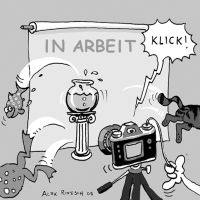Tricolor House Mouse (Mus musculus f. dom. 'Tricolor')
| Tricolor House Mouse Mus musculus f. dom. 'Tricolor' | |
|---|---|
| Name | Tricolor House Mouse |
| Name Lat. | Mus musculus f. dom. 'Tricolor' |
| Family | Murids |
| Family lat. | Muridae |
| Order | Rodents |
| Order lat. | Rodentia |
| Origin | Asia (breeding variety) |
| Climate | Temperate |
| Habitat | Steppes, bushland |
| Diet | Seeds, green fodder, insects |
| Behavior | ♂ territorial |
| Keeping | Pair, group |
| Care Level | Easy |
| Life Span | 3 years |
| Protection | No |
| Metric Units | |
| Size | 10 cm |
| Temperature | Room temperature |
| Housing | 80 x 50 x 50 cm |
| US Units | |
| Size | 3.9" |
| Temperature | Room temperature |
| Housing | 30" x 20" x 20" |
Distribution and habitat
The tricolored color mouse is a breeding variant of the color mouse. It is descended from the house mouse (Mus musculus), which arrived in the Mediterranean region as early as approx. 8,000 BC, coming from India via western Asia
Maintenance
Minimum dimensions for the enclosure
| 2-5 animals | L 80 x W 50 x H 50 cm with 2 levels |
The enclosure should be placed in a bright (no direct sunlight), quiet place. Terrariums need ventilation openings on the sides and must not be tightly closed at the top.
For the agile animals, the enclosure should be variedly structured with stones, roots and branches as well as with sisal ropes, wooden ladders, etc. and offer hiding and shelter possibilities (rodent houses, cork tubes, clay caves, etc.). Platforms connected with ramps expand the footprint. You will need food and drinking containers (water bottles), nesting material (hay, pulp) and a substrate for digging. Commercially available small animal or hemp litter is suitable as a substrate. The bedding depth should be about 10 cm. For the wear of their teeth must always be available nail material, such as untreated twigs and branches of fruit trees, and a rodent stone
They should be kept at room temperature and their natural day-night rhythm should be respected.
Diet
Their diet is mainly vegetarian, but they also require animal protein. The diet consists of a low-fat grain mixture, available from specialist retailers as "mouse food", supplemented with green food (root vegetables, wild herbs, zucchini, chicory, etc.), some animal protein (e.g. cottage cheese, a hard-boiled egg, mild sliced cheese), occasionally live insects (grasshoppers, crickets, etc.) and, especially during pregnancy and young rearing, insect and egg food. Fruit should be offered infrequently and in very small quantities. Drinking water must always be available in hanging bottles or in stable, open containers and, like food, must be offered fresh daily
A varied diet promotes health and prevents deficiency symptoms.
Behaviour and compatibility
They are very social creatures and should only be kept in pairs or in a group. It is recommended to keep only one (castrated) buck with several females or a pure female group. Fierce territorial fights can occur between unneutered males. When socializing, none of the animals should have a "home advantage" therefore, the enclosure must be thoroughly cleaned and the setup restructured beforehand. At the first sign of incompatibility, the animals must be separated immediately.
Reproduction and breeding
Testes can be clearly seen in sexually mature males, and the distance between the anus and the urethral opening is greater in juvenile males than in females.
The gestation period is 18-24 days. A litter usually consists of 3-15 young, which are born naked, blind and deaf. After about 2 weeks the eyes open. The young are suckled for 18 days and can be weaned from the mother after about 21 days. At the age of six weeks they are sexually mature, and they are ready for breeding from the eighth week. A female can have 5-8 litters per year
Important
Color mice are bred in many different color varieties. The tricolor color mouse is available in the color varieties 'black-red-white', 'black-cream-white' and 'blue-cream-white'. The color patches are irregularly distributed over the entire body. They are diurnal, but rest repeatedly (polyphasic). Running wheels must be injury-proof, have a closed running surface and back wall and a diameter of at least 20 cm. As escape animals they need sufficient retreat and hiding places, therefore the enclosure should also be somewhat elevated and not placed on the floor. They must not be grabbed or pulled by the tail, as the skin can easily tear and detach. Care should be taken to ensure thorough hygiene and contamination should be removed regularly
Further literature can be found in your pet store
References
Text: petdata; Image: Alex Rinesch
Source: BMEL (2014): Gutachten über Mindestanforderungen an die Haltung von Säugetieren; TEUBLER (2006): Meine Farbmaus zu Hause, bede Verlag
- Gemäß § 21 Abs. 5 Tierschutzgesetz idgF
